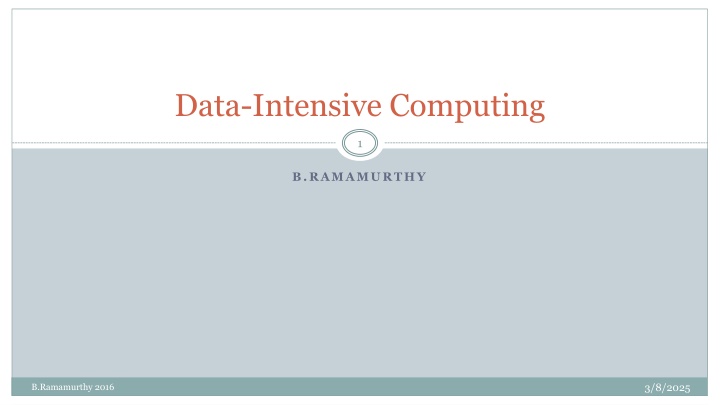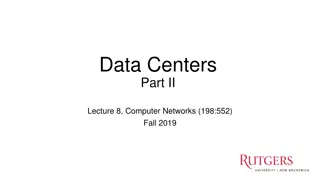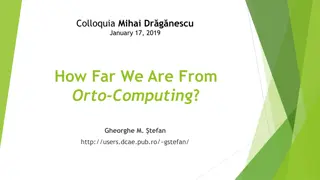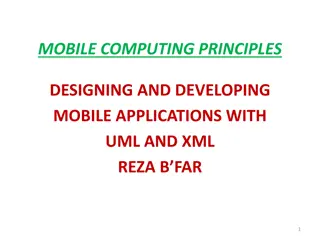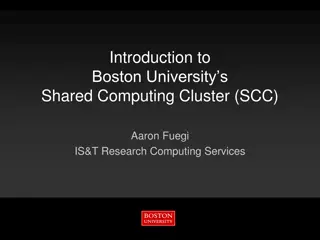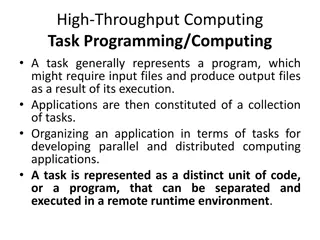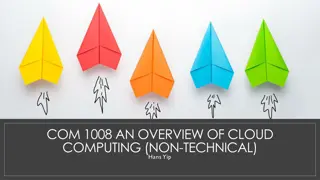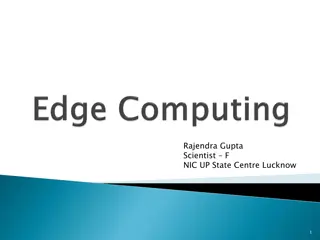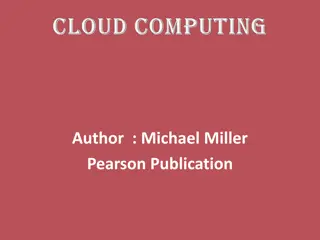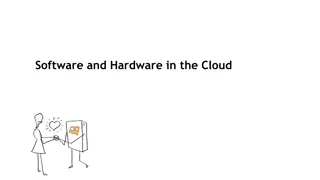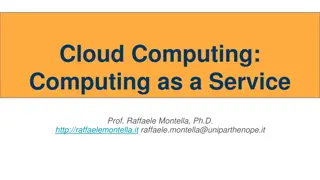Data-Intensive Computing: Trends, Challenges, and Tools
In the realm of data-intensive computing, various trends and challenges are shaping the landscape. From volume and velocity to veracity and variety, the importance of processing large datasets efficiently cannot be understated. Tools and techniques for handling big data are evolving rapidly, driving the need for informed decision-making and intelligence extraction. This course delves into the foundations of data analytics, statistical methods, machine learning, and cloud infrastructures, fostering a comprehensive understanding of data-driven improvements in research, work, and business processes.
Download Presentation

Please find below an Image/Link to download the presentation.
The content on the website is provided AS IS for your information and personal use only. It may not be sold, licensed, or shared on other websites without obtaining consent from the author.If you encounter any issues during the download, it is possible that the publisher has removed the file from their server.
You are allowed to download the files provided on this website for personal or commercial use, subject to the condition that they are used lawfully. All files are the property of their respective owners.
The content on the website is provided AS IS for your information and personal use only. It may not be sold, licensed, or shared on other websites without obtaining consent from the author.
E N D
Presentation Transcript
Data-Intensive Computing 1 B.RAMAMURTHY 3/8/2025 B.Ramamurthy 2016
Data-intensive computing 2 The phrase was initially coined by National Science Foundation (NSF) What is it? Volume, velocity, variety, veracity (uncertainty) (Gartner, IBM) How is it addressed? Why now? What do you expect to extract by processing this large data? Intelligence for decision making What is different now? Storage models, processing models Big Data, analytics and cloud infrastructures Summary 3/8/2025
Motivation 3 Tremendous advances have taken place in statistical methods and tools, machine learning and data mining approaches, and internet based dissemination tools for analysis and visualization. Many tools are open source and freely available for anybody to use. Is there an easy entry-point into learning these technologies? Can we make these tools easily accessible to the students, researchers and decision makers similar to how office productivity software is used? 3/8/2025 B.Ramamurthy 2016
High Level Goals for the course 4 Understand foundations of data analytics so that you can interpret and communicate results and make informed decisions Study and learn to apply common statistical methods and machine learning algorithms to solve business problems Learn to work with popular tools to analyze and visualize data; more importantly encourage consistency across departments on analytics/tools used Working with cloud for data storage and for deployment of applications Learn methods for mastering and applying emerging concepts and technologies for continuous data-driven improvements to your research/work/business processes Transform complex analytics into routine processes 3/8/2025 B.Ramamurthy 2016
Newer kinds of Data 5 New kinds of data from different sources (see p.23 of Data Science book) : tweets, geo location, emails, blogs Two major types: structured and unstructured data Structured data: data collected and stored according to well defined schema; Realtime stock quotes Unstructured data: messages from social media, news, talks, books, letters, manuscripts, court documents.. Regardless of their differences, they work in tandem in any effective big data operation. Companies wishing to make the most of their data should use tools that utilize the benefits of both. 5 We will discuss methods for analyzing both structured and unstructured data 3/8/2025 B.Ramamurthy 2016
Data Deluge: smallest to largest Bioinformatics data: from about 3.3 billion base pairs in a human genome to huge number of sequences of proteins and the analysis of their behaviors The internet: web logs, facebook, twitter, maps, blogs, etc.: Analytics Financial applications: that analyze volumes of data for trends and other deeper knowledge Health Care: huge amount of patient data, drug and treatment data The universe: The Hubble ultra deep telescope shows 100s of galaxies each with billions of stars: Sloan Digital Sky Survey: http://www.sdss.org/ 3/8/2025 6
Big-data Problem Solving Approaches Algorithmic: after all we have working towards this for ever: scalable/tracktable High Performance computing (HPC: multi-core) CCR has machines that are: 16 CPU , 32 core machine with 128GB RAM: openmp, MPI, etc. GPGPU programming: general purpose graphics processor (NVIDIA) Statistical packages like R running on parallel threads on powerful machines Machine learning algorithms on super computers Hadoop MapReduce like parallel processing. Spark like approaches providing in-memory computing models
Processing Granularity 3/8/2025 8 Data size: small Pipelined Instruction level Concurrent Thread level Service Object level Indexed File level Bina Ramamurthy 2011 Mega Block level Virtual System Level Data size: large
A Golden Era in Computing Heavy societal involvement Explosion of domain application s Powerful multi-core processors Superior software methodologies Proliferatio n of devices Virtualization leveraging the powerful hardware Wider bandwidth for communication 3/8/2025 9
Intelligence and Scale of Data 10 Intelligence is a set of discoveries made by federating/processing information collected from diverse sources. Information is a cleansed form of raw data. For statistically significant information we need reasonable amount of data. For gathering good intelligence we need large amount of information. As pointed out by Jim Grey in the Fourth Paradigm book enormous amount of data is generated by the millions of experiments and applications. Thus intelligence applications are invariably data-heavy, data-driven and data-intensive. Data is gathered from the web (public or private, covert or overt), generated by large number of domain applications. 3/8/2025
Intelligence (or origins of Big-data computing?) Search for Extra Terrestrial Intelligence (seti@home project) The Wow signal http://www.bigear.org/wow.htm http://www.bigear.org/wow.htm wowsignal 3/8/2025 11
Characteristics of intelligent applications 12 Google search: How is different from regular search in existence before it? It took advantage of the fact the hyperlinks within web pages form an underlying structure that can be mined to determine the importance of various pages. Restaurant and Menu suggestions: instead of Where would you like to go? Would you like to go to CityGrille ? Learning capacity from previous data of habits, profiles, and other information gathered over time. Collaborative and interconnected world inference capable: facebook friend suggestion Large scale data requiring indexing Do you know amazon is going to ship things before you order? Here 3/8/2025
Data-intensive application characteristics Models Algorithms (thinking) Data structures (infrastructure) AggregatedC ontent (Raw data) Reference Structures (knowledge) 13 3/8/2025
Basic Elements 14 Aggregated content: large amount of data pertinent to the specific application; each piece of information is typically connected to many other pieces. Ex: DBs Reference structures: Structures that provide one or more structural and semantic interpretations of the content. Reference structure about specific domain of knowledge come in three flavors: dictionaries, knowledge bases, and ontologies Algorithms: modules that allows the application to harness the information which is hidden in the data. Applied on aggregated content and some times require reference structure Ex: MapReduce Data Structures: newer data structures to leverage the scale and the WORM characteristics; ex: MS Azure, Apache Hadoop, Google BigTable 3/8/2025
Examples of data-intensive applications 15 Search engines Recommendation systems: CineMatch of Netflix Inc. movie recommendations Amazon.com: book/product recommendations Biological systems: high throughput sequences (HTS) Analysis: disease-gene match Query/search for gene sequences Space exploration Financial analysis 3/8/2025
More intelligent data-intensive applications 16 Social networking sites Mashups : applications that draw upon content retrieved from external sources to create entirely new innovative services. Portals Wikis: content aggregators; linked data; excellent data and fertile ground for applying concepts discussed in the text Media-sharing sites Online gaming Biological analysis Space exploration 3/8/2025
Algorithms 17 Statistical inference Machine learning is the capability of the software system to generalize based on past experience and the use of these generalization to provide answers to questions related old, new and future data. Data mining Soft computing Deep learning We also need algorithms that are specially designed for the emerging storage models and data characteristics. 3/8/2025
Different Type of Storage Internet introduced a new challenge in the form web logs, web crawler s data: large scale peta scale But observe that this type of data has an uniquely different characteristic than your transactional or the customer order data, or bank account data : The data type is write once read many (WORM) ; Privacy protected healthcare and patient information; Privacy protected healthcare and patient information; Historical financial data; Historical financial data; Other historical data Other historical data Relational file system and tables are insufficient. Large <key, value> stores (files) and storage management system. Built-in features for fault-tolerance, load balancing, data-transfer and aggregation, Clusters of distributed nodes for storage and computing. Computing is inherently parallel 3/8/2025 18
Big-data Concepts Originated from the Google File System (GFS) is the special <key, value> store Hadoop Distributed file system (HDFS) is the open source version of this. (Currently an Apache project) Parallel processing of the data using MapReduce (MR) programming model Challenges Formulation of MR algorithms Proper use of the features of infrastructure (Ex: sort) Best practices in using MR and HDFS An extensive ecosystem consisting of other components such as column-based store (Hbase, BigTable), big data warehousing (Hive), workflow languages, etc. 3/8/2025 19
Data & Analytics We have witnessed explosion in algorithmic solutions. In pioneer days they used oxen for heavy pulling, when one couldn t budge a log they didn t try to grow a larger ox. We shouldn t be trying for bigger computers, but for more systems of computers. Grace Hopper What you cannot achieve by an algorithm can be achieved by more data. Big data if analyzed right gives you better answers: Center for disease control prediction of flu vs. prediction of flu through search data 2 full weeks before the onset of flu season! http://www.google.org/flutrends/ 3/8/2025 20
Cloud Computing Cloud is a facilitator for Big Data computing and is an indispensable in this context Cloud provides processor, software, operating systems, storage, monitoring, load balancing, clusters and other requirements as a service Cloud offers accessibility to Big Data computing Cloud computing models: platform (PaaS), Microsoft Azure software (SaaS), Google App Engine (GAE) infrastructure (IaaS), Amazon web services (AWS) Services-based application programming interface (API) 3/8/2025 21
Top Ten Largest Databases 7000 6000 5000 Terabytes 4000 Top ten largest databases (2007) 3000 2000 1000 0 LOC CIA Amazon YOUTube ChoicePt Sprint Google AT&T NERSC Climate Ref: http://www.comparebusinessproducts.com/fyi/10-largest-databases-in-the-world/ 22 3/8/2025 B.Ramamurthy 2016
Top Ten Largest Databases in 2007 vs Facebook s cluster in 2010 21 PetaByte In 2010 7000 6000 5000 4000 Terabytes 3000 Top ten largest databases (2007) 2000 1000 0 Facebook LOC CIA Amazon YOUTube ChoicePt Sprint Google AT&T NERSC Climate Ref: http://www.comparebusinessproducts.com/fyi/10-largest-databases-in-the-world 23 3/8/2025 B.Ramamurthy 2016
Data Strategy 24 In this era of big data, what is your data strategy? Strategy as in simple Planning for the data challenge It is not only about big data: all sizes and forms of data Data collections from customers used to be an elaborate task: surveys, and other such instruments Nowadays data is available in abundance: thanks to the technological advances as well as the social networks Data is also generated by many of your own business processes and applications Data strategy means many different things: we will discuss this next 3/8/2025 B.Ramamurthy 2016
Components of a data Strategy1 25 Data integration Meta data Data modeling Organizational roles and responsibilities Performance and metrics Security and privacy Structured data management Unstructured data management Business intelligence Data analysis and visualization Tapping into social data This course will provide training in emerging technologies, tools, environments and APIs available for developing and implementing one or more of these components. 3/8/2025 B.Ramamurthy 2016
Data Strategy for newer kinds of data 26 How will you collect data? Aggregate data? What are your sources? (Eg. Social media) How will you store them? And Where? How will you use the data? Analyze them? Analytics? Data mining? Pattern recognition? How will you present or report the data to the stakeholders and decision makers? visualization? Archive the data for provenance and accountability. 3/8/2025 B.Ramamurthy 2016
Tools for Analytics 27 Elaborate tools with nifty visualizations; expensive licensing fees: Ex: Tableau, Tom Sawyer Software that you can buy for data analytics: Brilig, small, affordable but short-lived Open sources tools: Gephi, sporadic support Open source, freeware with excellent community involvement: R system Some desirable characteristics of the tools: simple, quick to apply, intuitive, useful, flat learning curve A demo to prove this point: data actions /decisions 3/8/2025 B.Ramamurthy 2016
Demo: Exam1 Grade: Traditional reporting 1 Q1 16.7 20.0 20.0 Q2 13.9 16.0 20.0 Q3 9.6 9.0 15.0 Q4 18.5 19.0 25.0 Q5 13.7 17.0 20.0 Total 72.4 76.0 90.0 Q1 16.0 80.1% Q2 14.2 71.1% Q3 9.6 Q4 19.4 77.4% Q5 14.0 70.2% Total 73.2 73.2% 64.0% Q1 17.3 86.7% Q2 13.6 67.8% Q3 9.7 Q4 17.6 70.3% Q5 13.3 66.7% Total 71.5 71.5% 64.6% Question 1..5, total, mean, median, mode; mean ver1, mean ver2 28 3/8/2025 B.Ramamurthy 2016
Traditional approach 2: points vs #students 29 Distribution of exam1 points 3/8/2025 B.Ramamurthy 2016
Individual questions analyzed.. 30 3/8/2025 B.Ramamurthy 2016
Interpretation and action/decisions 31 3/8/2025 B.Ramamurthy 2016
R-code 32 data2<-read.csv(file.choose()) exam1<-data2$midterm hist(exam1, col=rainbow(8)) boxplot(data2, col=rainbow(6)) boxplot(data2,col=c("orange","green","blue","grey","yellow", "sienna")) fn<-boxplot(data2,col=c("orange","green","blue","grey","yellow", "pink"))$stats text(5.55, fn[1,6], paste("Minimum =", fn[1,6]), adj=0, cex=.7) text(5.55, fn[2,6], paste("LQuartile =", fn[2,6]), adj=0, cex=.7) text(5.0, fn[3,6], paste("Median =", fn[3,6]), adj=0, cex=.7) text(5.55, fn[4,6], paste("UQuartile =", fn[4,6]), adj=0, cex=.7) text(5.55, fn[5,6], paste("Maximum =", fn[5,6]), adj=0, cex=.7) grid(nx=NA, ny=NULL) 3/8/2025 B.Ramamurthy 2016
Demo Details 33 Grade data stored in excel file and common input format Converted this file to csv Start a R Studio project Read in the csv data (using a file chooser option) into data2 boxplot(data2) That is it. You can now add legends, colors, and labels to make it presentable. Export the plot as a image or pdf to report the results 3/8/2025 B.Ramamurthy 2016
Todays Topic: Exploratory data analysis (EDA) 34 The R Programming language The R project for statistical computing R Studio integrated development environment (IDE) Data analysis with R: charts, plots, maps, packages Also look at the CRAN: Comprehensive R Archive Network Understanding your data Basic statistical analysis Chapter 1 : What is Data Science? Chapter 2: Exploratory Data Analysis and Data Science Process 3/8/2025 B.Ramamurthy 2016
R Language 35 R is a software package for statistical computing. R is an interpreted language It is open source with high level of contribution from the community R is very good at plotting graphics, analyzing data, and fitting statistical models using data that fits in the computer s memory. It s not as good at storing data in complicated structures, efficiently querying data, or working with data that doesn t fit in the computer s memory. 3/8/2025 B.Ramamurthy 2016
R Programming Language3,4 36 R is popular language for statistical analysis of data, visualization and reporting. It is a complete programming language. R is a free software: Gnu General Public Licensing (GPL) R Studio is a powerful IDE for R. R is not a tool for data acquisition/collection/data entry. This is a major point on which it differs from Excel and other data input applications. 3/8/2025 B.Ramamurthy 2016
Why R? 37 There are many packages available for statistical analysis such as SAS and SPSS but they are expensive (user license based) and are proprietary. R is open source and it can pretty much do what SAS can do but free. R is considered one of the best statistical tools in the world. People can submit their own R packages/libraries, using latest cutting edge techniques. To date R has got almost 5,000 packages in the CRAN (Comprehensive R Archive Network The site which maintains the R project) repository. R is great for exploratory data analysis (EDA): for understanding the nature of your data and quickly create useful visualization 3/8/2025 B.Ramamurthy 2016
R Packages 38 An R package is a set of related functions To use a package you need to load it into R R offers a large number of packages for various vertical and horizontal domains: Horizontal: display graphics, statistical packages, machine learning Verticals: wide variety of industries: analyzing stock market data, modeling credit risks, social sciences, automobile data 3/8/2025 B.Ramamurthy 2016
R Packages 39 A package is a collection of functions and data files bundled together. In order to use the components of a package it needs to be installed in the local library of the R environment. Loading packages Custom packages Building packages Activity: explore what R packages are available, if any, for your domain http://cran.r-project.org/web/packages/available_packages_by_name.html Later on, try to create a custom package for your business domain. 3/8/2025 B.Ramamurthy 2016
Library 40 Library Package Class R also provides many data sets for exploring its features 3/8/2025 B.Ramamurthy 2016
Learning R 41 R Basics, fundamentals The R language Working with data Statistics with R language R syntax R Control structures R Objects R formulas Install and use packages Quick overview and tutorial 3/8/2025 B.Ramamurthy 2016
R Studio 42 Lets examine the R studio environment 3/8/2025 B.Ramamurthy 2016
Input Data sources 43 Data for the analytics can be from many different sources: simple .csv file, relational database, xml based web documents, sources on the cloud (dropbox, storage drives). Today we will examine how to input data into R from: csv file and by scraping the web files. This will allow you to input any web data and excel data you have into R for processing and analytics. We will discuss ODBC and cloud sources in a later lecture. 3/8/2025 B.Ramamurthy 2016
Features of RStudio 44 Regions of RStudio: (i) console, (ii) data, (iii) script, (iv) plots and packages Primary feature: Project is a collection of files: data, graphs, R script: lets create a new project R allows all the basic arithmetic: +, - , variables Vectors: collection of same type of elements; very important data element Creating a vector; changing a vector; factoring a vector x<- c(1,4,9,19) Calling a function: mean (x) Missing data: NA (not available), NULL(absence of anything) z<- c(8, NA, 19) z <- c(8,NULL, 18) znew<-na.omit(z) 3/8/2025 B.Ramamurthy 2016
Features (contd.) 45 Ingesting (reading) data into R Reading csv Reading from the web We will spend some time here to plan your data collection strategy Data included with R Lot of historical data (old data is easy to publicize/declassify) Simple commands to work with data sets summary(data) head(data) 3/8/2025 B.Ramamurthy 2016
References 46 [1] S. Adelman, L. Moss, M. Abai. Data Strategy. Addison-Wesley, 2005. [2] T. Davenport. A Predictive Analytics Primer. Sept2, 2014, Harvard Business Review. http://blogs.hbr.org/2014/09/a-predictive-analytics-primer/ [3] The R project, http://www.r-project.org/ [4] J.P. Lander. R for Everyone: Advanced Analytics and graphics. Addison Wesley. 2014. [5] M. NemSchoff. A quick guide to structured and unstructured data. In Smart Data Collective, June 28, 2014. 3/8/2025 B.Ramamurthy 2016
Summary 47 We are entering a watershed moment in the internet era. This involves in its core and center, big data analytics and tools that provide intelligence in a timely manner to support decision making. Newer storage models, processing models, and approaches have emerged. We will learn about these and develop software using these newer approaches to data. 3/8/2025 B.Ramamurthy 2016
